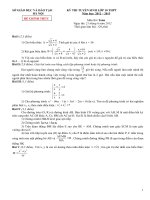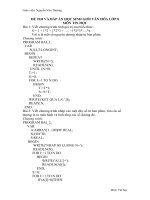Đề thi và đáp án CMO năm 2013
Bạn đang xem bản rút gọn của tài liệu. Xem và tải ngay bản đầy đủ của tài liệu tại đây (576.93 KB, 10 trang )
<span class='text_page_counter'>(1)</span><div class='page_container' data-page=1>
45
th<sub>Canadian Mathematical Olympiad</sub>
Wednesday, March 27, 2013
Problems and Solutions
1. Determine all polynomials <i>P</i>(<i>x</i>) with real coefficients such that
(<i>x</i>+ 1)<i>P</i>(<i>x−</i>1)<i>−</i>(<i>x−</i>1)<i>P</i>(<i>x</i>)
is a constant polynomial.
Solution 1: The answer is <i>P</i>(<i>x</i>) being any constant polynomial and <i>P</i>(<i>x</i>) <i>≡</i>
<i>kx</i>2<sub>+</sub><i><sub>kx</sub></i><sub>+</sub><i><sub>c</sub></i> <sub>for any (nonzero) constant</sub> <i><sub>k</sub></i> <sub>and constant</sub> <i><sub>c</sub></i><sub>.</sub>
Let Λ be the expression (<i>x</i>+ 1)<i>P</i>(<i>x−</i>1)<i>−</i>(<i>x−</i>1)<i>P</i>(<i>x</i>), i.e. the expression in the
problem statement.
Substituting <i>x</i> = <i>−</i>1 into Λ yields 2<i>P</i>(<i>−</i>1) and substituting <i>x</i> = 1 into Λ yield
2<i>P</i>(0). Since (<i>x</i>+1)<i>P</i>(<i>x−</i>1)<i>−</i>(<i>x−</i>1)<i>P</i>(<i>x</i>) is a constant polynomial, 2<i>P</i>(<i>−</i>1) = 2<i>P</i>(0).
Hence, <i>P</i>(<i>−</i>1) = <i>P</i>(0).
Let <i>c</i>=<i>P</i>(<i>−</i>1) =<i>P</i>(0) and <i>Q</i>(<i>x</i>) = <i>P</i>(<i>x</i>)<i>−c</i>. Then <i>Q</i>(<i>−</i>1) =<i>Q</i>(0) = 0. Hence,
0<i>,−</i>1 are roots of <i>Q</i>(<i>x</i>). Consequently,<i>Q</i>(<i>x</i>) = <i>x</i>(<i>x</i>+ 1)<i>R</i>(<i>x</i>) for some polynomial<i>R</i>.
Then <i>P</i>(<i>x</i>)<i>−c</i>=<i>x</i>(<i>x</i>+ 1)<i>R</i>(<i>x</i>), or equivalently, <i>P</i>(<i>x</i>) =<i>x</i>(<i>x</i>+ 1)<i>R</i>(<i>x</i>) +<i>c</i>.
Substituting this into Λ yield
(<i>x</i>+ 1)((<i>x−</i>1)<i>xR</i>(<i>x−</i>1) +<i>c</i>)<i>−</i>(<i>x−</i>1)(<i>x</i>(<i>x</i>+ 1)<i>R</i>(<i>x</i>) +<i>c</i>)
This is a constant polynomial and simplifies to
</div>
<span class='text_page_counter'>(2)</span><div class='page_container' data-page=2>
Since this expression is a constant, so is<i>x</i>(<i>x−</i>1)(<i>x</i>+ 1)(<i>R</i>(<i>x−</i>1)<i>−R</i>(<i>x</i>)). Therefore,
<i>R</i>(<i>x−</i>1)<i>−R</i>(<i>x</i>) = 0 as a polynomial. Therefore, <i>R</i>(<i>x</i>) = <i>R</i>(<i>x−</i>1) for all <i>x</i> <i>∈</i> R.
Then <i>R</i>(<i>x</i>) is a polynomial that takes on certain values for infinitely values of <i>x</i>.
Let <i>k</i> be such a value. Then <i>R</i>(<i>x</i>)<i>−k</i> has infinitely many roots, which can occur
if and only if <i>R</i>(<i>x</i>)<i>−k</i> = 0. Therefore, <i>R</i>(<i>x</i>) is identical to a constant <i>k</i>. Hence,
<i>Q</i>(<i>x</i>) = <i>kx</i>(<i>x</i>+1) for some constant<i>k</i>. Therefore,<i>P</i>(<i>x</i>) = <i>kx</i>(<i>x</i>+1)+<i>c</i>=<i>kx</i>2<sub>+</sub><i><sub>kx</sub></i><sub>+</sub><i><sub>c</sub></i><sub>.</sub>
Finally, we verify that all such<i>P</i>(<i>x</i>) =<i>kx</i>(<i>x</i>+ 1) +<i>c</i>work. Substituting this into
Λ yield
(<i>x</i>+ 1)(<i>kx</i>(<i>x−</i>1) +<i>c</i>)<i>−</i>(<i>x−</i>1)(<i>kx</i>(<i>x</i>+ 1) +<i>c</i>)
= <i>kx</i>(<i>x</i>+ 1)(<i>x−</i>1) +<i>c</i>(<i>x</i>+ 1)<i>−kx</i>(<i>x</i>+ 1)(<i>x−</i>1)<i>−c</i>(<i>x−</i>1) = 2<i>c.</i>
Hence, <i>P</i>(<i>x</i>) = <i>kx</i>(<i>x</i>+ 1) +<i>c</i> = <i>kx</i>2 <sub>+</sub><i><sub>kx</sub></i><sub>+</sub><i><sub>c</sub></i> <sub>is a solution to the given equation</sub>
for any constant <i>k</i>. Note that this solution also holds for <i>k</i> = 0. Hence, constant
polynomials are also solutions to this equation. Ô
Solution 2: As in Solution 1, any constant polynomial <i>P</i> satisfies the given
property. Hence, we will assume that <i>P</i> is not a constant polynomial.
Let<i>n</i> be the degree of <i>P</i>. Since <i>P</i> is not constant,<i>n</i> <i>≥</i>1. Let
<i>P</i>(<i>x</i>) =
<i>n</i>
X
<i>i</i>=0
<i>aixi,</i>
with <i>an6</i>= 0. Then
(<i>x</i>+ 1)
<i>n</i>
X
<i>i</i>=0
<i>ai</i>(<i>x−</i>1)<i>i−</i>(<i>x−</i>1)
<i>n</i>
X
<i>i</i>=0
<i>aixi</i> =<i>C,</i>
for some constant <i>C</i>. We will compare the coefficient of <i>xn</i> <sub>of the left-hand side of</sub>
this equation with the right-hand side. Since <i>C</i> is a constant and <i>n</i> <i>≥</i> 1, the
coeffi-cient of<i>xn</i> <sub>of the right-hand side is equal to zero. We now determine the coefficient</sub>
of <i>xn</i> <sub>of the left-hand side of this expression.</sub>
The left-hand side of the equation simplifies to
<i>x</i>
<i>n</i>
X
<i>i</i>=0
<i>ai</i>(<i>x−</i>1)<i>i</i>+
<i>n</i>
X
<i>i</i>=0
<i>ai</i>(<i>x−</i>1)<i>i−x</i>
<i>n</i>
X
<i>i</i>=0
<i>aixi</i>+
<i>n</i>
X
<i>i</i>=0
</div>
<span class='text_page_counter'>(3)</span><div class='page_container' data-page=3>
We will determine the coefficient<i>xn</i> <sub>of each of these four terms.</sub>
By the Binomial Theorem, the coefficient of <i>xn</i> <sub>of the first term is equal to that</sub>
of <i>x</i>(<i>an−</i>1(<i>x−</i>1)<i>n−</i>1+<i>an(x−</i>1)<i>n</i>) =<i>an−</i>1<i>−</i>
¡ <i><sub>n</sub></i>
<i>n−</i>1
¢
<i>an</i> =<i>an−</i>1<i>−nan.</i>
The coefficient of<i>xn</i><sub>of the second term is equal to that of</sub> <i><sub>a</sub></i>
<i>n</i>(<i>x−</i>1)<i>n</i>, which is<i>an</i>.
The coefficient of <i>xn</i> <sub>of the third term is equal to</sub> <i><sub>a</sub></i>
<i>n−</i>1 and that of the fourth
term is equal to<i>an</i>.
Summing these four coefficients yield <i>an−</i>1<i>−nan</i>+<i>an−an−</i>1+<i>an</i>= (2<i>−n</i>)<i>an</i>.
This expression is equal to 0. Since <i>an</i> <i>6</i>= 0, <i>n</i> = 2. Hence, <i>P</i> is a quadratic
polynomial.
Let<i>P</i>(<i>x</i>) = <i>ax</i>2<sub>+</sub><i><sub>bx</sub></i><sub>+</sub><i><sub>c</sub></i><sub>, where</sub> <i><sub>a, b, c</sub></i><sub>are real numbers with</sub> <i><sub>a</sub><sub>6</sub></i><sub>= 0. Then</sub>
(<i>x</i>+ 1)(<i>a</i>(<i>x−</i>1)2<sub>+</sub><i><sub>b</sub></i><sub>(</sub><i><sub>x</sub><sub>−</sub></i><sub>1) +</sub><i><sub>c</sub></i><sub>)</sub><i><sub>−</sub></i><sub>(</sub><i><sub>x</sub><sub>−</sub></i><sub>1)(</sub><i><sub>ax</sub></i>2<sub>+</sub><i><sub>bx</sub></i><sub>+</sub><i><sub>c</sub></i><sub>) =</sub> <i><sub>C.</sub></i>
Simplifying the left-hand side yields
(<i>b−a</i>)<i>x</i>+ 2<i>c</i>= 2<i>C.</i>
Therefore, <i>b−a</i> = 0 and 2<i>c</i> = 2<i>C</i>. Hence, <i>P</i>(<i>x</i>) = <i>ax</i>2 <sub>+</sub><i><sub>ax</sub></i><sub>+</sub><i><sub>c</sub></i><sub>. As in Solution 1,</sub>
</div>
<span class='text_page_counter'>(4)</span><div class='page_container' data-page=4>
2. The sequence<i>a</i>1<i>, a</i>2<i>, . . . , an</i> consists of the numbers 1<i>,</i>2<i>, . . . , n</i>in some order. For
which positive integers <i>n</i> is it possible that 0<i>, a</i>1<i>, a</i>1 +<i>a</i>2<i>, . . . , a</i>1 +<i>a</i>2 +<i>. . .</i>+<i>an</i> all
have different remainders when divided by<i>n</i>+ 1?
Solution: It is possible if and only if <i>n</i> is odd.
If <i>n</i> is even, then <i>a</i>1 +<i>a</i>2 +<i>. . .</i>+<i>an</i> = 1 + 2 +<i>. . .</i>+<i>n</i> = <i>n</i><sub>2</sub> <i>·</i>(<i>n</i> + 1), which is
congruent to 0 mod <i>n</i>+ 1. Therefore, the task is impossible.
Now suppose<i>n</i>is odd. We will show that we can construct<i>a</i>1<i>, a</i>2<i>, . . . , an</i>that
sat-isfy the conditions given in the problem. Then let<i>n</i>= 2<i>k</i>+ 1 for some non-negative
integer<i>k</i>. Consider the sequence: 1<i>,</i>2<i>k,</i>3<i>,</i>2<i>k−</i>2<i>,</i>5<i>,</i>2<i>k−</i>3<i>, . . . ,</i>2<i>,</i>2<i>k</i>+ 1, i.e. for each
1<i>≤i≤</i>2<i>k</i>+ 1, <i>ai</i> =<i>i</i> if <i>i</i> is odd and<i>ai</i> = 2<i>k</i>+ 2<i>−i</i> if <i>i</i> is even.
We first show that each term 1<i>,</i>2<i>, . . . ,</i>2<i>k</i>+ 1 appears exactly once. Clearly, there
are 2<i>k</i>+ 1 terms. For each odd number <i>m</i> in <i>{</i>1<i>,</i>2<i>, . . . ,</i>2<i>k</i>+ 1<i>}</i>, <i>am</i> =<i>m</i>. For each
even number <i>m</i> in this set, <i>a</i>2<i>k</i>+2<i>−m</i> = 2<i>k</i> + 2<i>−</i>(2<i>k</i>+ 2<i>−m</i>) = <i>m</i>. Hence, every
number appears in <i>a</i>1<i>, . . . , a</i>2<i>k</i>+1. Hence, <i>a</i>1<i>, . . . , a</i>2<i>k</i>+1 does consist of the numbers
1<i>,</i>2<i>, . . . ,</i>2<i>k</i>+ 1 in some order.
We now determine <i>a</i>1+<i>a</i>2 +<i>. . .</i>+<i>am</i> (mod 2<i>k</i>+ 2). We will consider the cases
when <i>m</i> is odd and when <i>m</i> is even separately. Let <i>bm</i> =<i>a</i>1+<i>a</i>2<i>. . .</i>+<i>am</i>.
If <i>m</i> is odd, note that <i>a</i>1 <i>≡</i> 1 (mod 2<i>k</i> + 2), <i>a</i>2 +<i>a</i>3 = <i>a</i>4 +<i>a</i>5 = <i>. . .</i> = <i>a</i>2<i>k</i> +
<i>a</i>2<i>k</i>+1 = 2<i>k</i>+ 3<i>≡</i>1 (mod 2<i>k</i>+ 2). Therefore, <i>{b</i>1<i>, b</i>3<i>, . . . , b</i>2<i>k</i>+1<i>}</i>=<i>{</i>1<i>,</i>2<i>,</i>3<i>, . . . , k</i>+ 1<i>}</i>
(mod 2<i>k</i>+ 2).
If <i>m</i> is even, note that <i>a</i>1 +<i>a</i>2 = <i>a</i>3 +<i>a</i>4 = <i>. . .</i> = <i>a</i>2<i>k−</i>1 +<i>a</i>2<i>k</i> = 2<i>k</i>+ 1 <i>≡ −</i>1
(mod 2<i>k</i> + 2). Therefore, <i>{b</i>2<i>, b</i>4<i>, . . . , b</i>2<i>k}</i> = <i>{−</i>1<i>,−</i>2<i>, . . . ,−k}</i> (mod 2<i>k</i> + 2) <i>≡</i>
<i>{</i>2<i>k</i>+ 1<i>,</i>2<i>k, . . . , k</i>+ 2<i>}</i> (mod 2<i>k</i>+ 2).
Therefore, <i>b</i>1<i>, b</i>2<i>, . . . , b</i>2<i>k</i>+1 do indeed have different remainders when divided by
</div>
<span class='text_page_counter'>(5)</span><div class='page_container' data-page=5>
3. Let<i>G</i> be the centroid of a right-angled triangle <i>ABC</i> with ∠BCA = 90<i>◦</i><sub>. Let</sub> <i><sub>P</sub></i>
be the point on ray <i>AG</i> such that ∠CP A=∠CAB, and let <i>Q</i> be the point on ray
<i>BG</i>such that ∠CQB =∠ABC. Prove that the circumcircles of triangles <i>AQG</i>and
<i>BP G</i>meet at a point on side <i>AB</i>.
Solution 1. Since∠C = 90<i>◦</i><sub>, the point</sub><i><sub>C</sub></i><sub>lies on the semicircle with diameter</sub><i><sub>AB</sub></i>
which implies that, if <i>M</i> is te midpoint of side <i>AB</i>, then <i>MA</i> =<i>MC</i> = <i>MB</i>. This
implies that triangle <i>AMC</i> is isosceles and hence that∠ACM =∠A. By definition,
<i>G</i> lies on segment <i>M</i> and it follows that ∠ACG = ∠ACM = ∠A = ∠CP A. This
implies that triangles <i>AP C</i> and <i>ACG</i> are similar and hence that <i>AC</i>2 <sub>=</sub> <i><sub>AG</sub><sub>·</sub><sub>AP</sub></i><sub>.</sub>
Now if<i>D</i>denotes the foot of the perpendicular from<i>C</i>to<i>AB</i>, it follows that triangles
<i>ACD</i>and<i>ABC</i> are similar which implies that<i>AC</i>2 <sub>=</sub><i><sub>AD·AB</sub></i><sub>. Therefore</sub><i><sub>AG·AP</sub></i> <sub>=</sub>
<i>AC</i>2 <sub>=</sub><i><sub>AD</sub><sub>·AB</sub></i> <sub>and, by power of a point, quadrilateral</sub><i><sub>DGP B</sub></i><sub>is cyclic. This implies</sub>
that <i>D</i> lies on the circumcircle of triangle <i>BP G</i> and, by a symmetric argument, it
follows that <i>D</i> also lies on the circumcircle of triangle <i>AGQ</i>. Therefore these two
circumcircles meet at the point <i>D</i> on side<i>AB</i>.
Solution 2. Define <i>D</i> and <i>M</i> as in Solution 1. Let <i>R</i> be the point on side <i>AB</i>
such that <i>AC</i> = <i>CR</i> and triangle <i>ACR</i> is isosceles. Since ∠CRA= ∠A = ∠CP A,
it follows that <i>CP RA</i> is cyclic and hence that∠GP R=∠AP R=∠ACR= 180<i>◦<sub>−</sub></i>
2∠A. As in Solution 1, <i>MC</i> =<i>MB</i> and hence ∠GMR=∠CM B = 2∠A = 180<i>◦<sub>−</sub></i>
</div>
<span class='text_page_counter'>(6)</span><div class='page_container' data-page=6>
4. Let <i>n</i> be a positive integer. For any positive integer <i>j</i> and positive real number
<i>r</i>, define
<i>fj</i>(<i>r</i>) = min (<i>jr, n</i>) + min
à
<i>j</i>
<i>r, n</i>
ả
<i>,</i> and <i>gj</i>(<i>r</i>) = min (<i>djre, n</i>) + min
àằ
<i>j</i>
<i>r</i>
ẳ
<i>, n</i>
ả
<i>,</i>
where<i>dxe</i> denotes the smallest integer greater than or equal to <i>x</i>. Prove that
<i>n</i>
X
<i>j</i>=1
<i>fj</i>(<i>r</i>)<i>≤n</i>2+<i>n</i> <i>≤</i>
<i>n</i>
X
<i>j</i>=1
<i>gj(r</i>)<i>.</i>
Solution 1: We first prove the left hand side inequality. We begin by drawing
an<i>n×n</i>board, with corners at (0<i>,</i>0)<i>,</i>(<i>n,</i>0)<i>,</i>(0<i>, n</i>) and (<i>n, n</i>) on the Cartesian plane.
Consider the line <i>`</i> with slope <i>r</i> passing through (0<i>,</i>0). For each <i>j</i> <i>∈ {</i>1<i>, . . . , n}</i>,
consider the point (<i>j,</i>min(<i>jr, n</i>)). Note that each such point either lies on <i>`</i> or the
top edge of the board. In the <i>jth</i> <sub>column from the left, draw the rectangle of height</sub>
min(<i>jr, n</i>). Note that the sum of the <i>n</i> rectangles is equal to the area of the board
under the line <i>`</i> plus <i>n</i> triangles (possibly with area 0) each with width at most 1
and whose sum of the heights is at most<i>n</i>. Therefore, the sum of the areas of these
<i>n</i> triangles is at most <i>n/</i>2. Therefore, P<i>n<sub>j</sub></i><sub>=1</sub>min(<i>jr, n</i>) is at most the area of the
square under <i>`</i> plus <i>n/</i>2.
Consider the line with slope 1<i>/r</i>. By symmetry about the line <i>y</i>=<i>x</i>, the area of
the square under the line with slope 1<i>/r</i> is equal to the area of the square above the
line <i>`</i>. Therefore, using the same reasoning as before, P<i>n<sub>j</sub></i><sub>=1</sub>min(<i>j/r, n</i>) is at most
the area of the square above<i>`</i> plus <i>n/</i>2.
Therefore,P<i>n<sub>j</sub></i><sub>=1</sub><i>fj</i>(<i>r</i>) =
P<i><sub>n</sub></i>
<i>j</i>=1(min(<i>jr, n</i>) + min(<i>rj, n</i>)) is at most the area of the
board plus<i>n</i>, which is<i>n</i>2<sub>+</sub><i><sub>n</sub></i><sub>. This proves the left hand side inequality.</sub>
To prove the right hand side inequality, we will use the following lemma:
Lemma: Consider the line<i>`</i> with slope<i>s</i> passing through (0<i>,</i>0). Then the
num-ber of squares on the board that contain an interior point below<i>`</i>isP<i>n<sub>j</sub></i><sub>=1</sub>min (<i>djse, n</i>).
<i>Proof of Lemma:</i> For each<i>j</i> <i>∈ {</i>1<i>, . . . , n}</i>, we count the number of squares in the
</div>
<span class='text_page_counter'>(7)</span><div class='page_container' data-page=7>
total, the number of such squares is min(<i>djse, n</i>). Summing over all<i>j</i> <i>∈ {</i>1<i>,</i>2<i>, . . . , n}</i>
proves the lemma. <i>End Proof of Lemma</i>
By the lemma, the rightmost expression of the inequality is equal to the number
of squares containing an interior point below the line with slope <i>r</i> plus the number
of squares containing an interior point below the line with slope 1<i>/r</i>. By symmetry
about the line<i>y</i>=<i>x</i>, the latter number is equal to the number of squares containing
an interior point above the line with slope <i>r</i>. Therefore, the rightmost expression
of the inequality is equal to the number of squares of the board plus the number of
squares of which <i>`</i> passes through the interior. The former is equal to <i>n</i>2<sub>. Hence, to</sub>
prove the inequality, it suffices to show that every line passes through the interior of
at least <i>n</i> squares. Since <i>`</i> has positive slope, each <i>`</i> passes through either <i>n</i> rows
and/or<i>n</i> columns. In either case,<i>`</i> passes through the interior of at least<i>n</i> squares.
Hence, the right inequality holds. Ô
Solution 2: We first prove the left inequality. Define the function <i>f</i>(<i>r</i>) =
P<i><sub>n</sub></i>
<i>j</i>=1<i>fj</i>(<i>r</i>). Note that <i>f</i>(<i>r</i>) = <i>f</i>(1<i>/r</i>) for all <i>r ></i> 0. Therefore, we may assume
that <i>r≥</i>1.
Let<i>m</i>=<i>bn/rc</i>, where<i>bxc</i>denotes the largest integer less than or equal to<i>x</i>. Then
min(<i>jr, n</i>) =<i>jr</i> for all <i>j</i> <i>∈ {</i>1<i>, . . . , m}</i>and min(<i>jr, n</i>) =<i>n</i> for all <i>j</i> <i>∈ {m</i>+ 1<i>, . . . , n}</i>.
Note that since<i>r</i> <i>≥</i>1, min(<i>j/r, n</i>)<i>≤n</i> for all <i>j</i> <i>∈ {</i>1<i>, . . . , n}</i>. Therefore,
<i>f</i>(<i>r</i>) =
<i>n</i>
X
<i>j</i>=1
<i>fj</i>(<i>r</i>) = (1 + 2 +<i>. . . m</i>)<i>r</i>+ (<i>n−m</i>)<i>n</i>+ (1 + 2 +<i>. . .</i>+<i>n</i>)<i>·</i>
1
<i>r</i>
= <i>m</i>(<i>m</i>+ 1)
2 <i>·r</i>+
<i>n</i>(<i>n</i>+ 1)
2 <i>·</i>
1
<i>r</i> +<i>n</i>(<i>n−m</i>) (1)
Then by (??), note that <i>f</i>(<i>r</i>)<i>≤n</i>2<sub>+</sub><i><sub>n</sub></i> <sub>if and only if</sub>
<i>m</i>(<i>m</i>+ 1)<i>r</i>
2 +
<i>n</i>(<i>n</i>+ 1)
2<i>r</i> <i>≤n</i>(<i>m</i>+ 1)
if and only if
<i>m</i>(<i>m</i>+ 1)<i>r</i>2<sub>+</sub><i><sub>n</sub></i><sub>(</sub><i><sub>n</sub></i><sub>+ 1)</sub><i><sub>≤</sub></i><sub>2</sub><i><sub>rn</sub></i><sub>(</sub><i><sub>m</sub></i><sub>+ 1)</sub> <sub>(2)</sub>
Since <i>m</i> = <i>bn/rc</i>, there exist a real number <i>b</i> satisfying 0 <i>≤</i> <i>b < r</i> such that
<i>n</i>=<i>mr</i>+<i>b</i>. Substituting this into (??) yields
</div>
<span class='text_page_counter'>(8)</span><div class='page_container' data-page=8>
if and only if
2<i>m</i>2<i><sub>r</sub></i>2<sub>+</sub><i><sub>mr</sub></i>2<sub>+ (2</sub><i><sub>mb</sub></i><sub>+</sub><i><sub>m</sub></i><sub>)</sub><i><sub>r</sub></i><sub>+</sub><i><sub>b</sub></i>2<sub>+</sub><i><sub>b</sub></i> <i><sub>≤</sub></i><sub>2</sub><i><sub>m</sub></i>2<i><sub>r</sub></i>2<sub>+ 2</sub><i><sub>mr</sub></i>2<sub>+ 2</sub><i><sub>mbr</sub></i><sub>+ 2</sub><i><sub>br,</sub></i>
which simplifies to <i>mr</i> + <i>b</i>2 <sub>+</sub><i><sub>b</sub></i> <i><sub>≤</sub></i> <i><sub>mr</sub></i>2 <sub>+ 2</sub><i><sub>br</sub></i> <i><sub>⇔</sub></i> <i><sub>b</sub></i><sub>(</sub><i><sub>b</sub></i> <sub>+ 1</sub> <i><sub>−</sub></i><sub>2</sub><i><sub>r</sub></i><sub>)</sub> <i><sub>≤</sub></i> <i><sub>mr</sub></i><sub>(</sub><i><sub>r</sub></i> <i><sub>−</sub></i> <sub>1)</sub> <i><sub>⇔</sub></i>
<i>b</i>((<i>b−r</i>) + (1<i>−r</i>))<i>≤mr</i>(<i>r−</i>1). This is true since
<i>b</i>((<i>b−r</i>) + (1<i>−r</i>))<i>≤</i>0<i>≤mr</i>(<i>r−</i>1)<i>,</i>
which holds since <i>r≥</i>1 and <i>b < r</i>. Therefore, the left inequality holds.
We now prove the right inequality. Define the function <i>g</i>(<i>r</i>) = P<i>n<sub>j</sub></i><sub>=1</sub> = <i>gj</i>(<i>r</i>).
Note that <i>g</i>(<i>r</i>) = <i>g</i>(1<i>/r</i>) for all <i>r ></i> 0. Therefore, we may assume that <i>r</i> <i>≥</i> 1. We
will consider two cases;<i>r</i> <i>≥n</i> and 1<i>≤r < n</i>.
If <i>r</i> <i>≥</i> <i>n</i>, then min(<i>djre, n</i>) = <i>n</i> and min(<i>dj/re, n</i>) = 1 for all <i>j</i> <i>∈ {</i>1<i>, . . . , n}</i>.
Hence, <i>gj</i>(<i>r</i>) = <i>n</i>+ 1 for all <i>j</i> <i>∈ {</i>1<i>, . . . , n}</i>. Therefore, <i>g</i>(<i>r</i>) = <i>n</i>(<i>n</i>+ 1) = <i>n</i>2 +<i>n</i>,
implying that the inequality is true.
Now we consider the case 1 <i>≤</i> <i>r < n</i>. Let <i>m</i> = <i>bn/rc</i>. Hence, <i>jr</i> <i>≤</i> <i>n</i> for all
<i>j</i> <i>∈ {</i>1<i>, . . . , m}</i>, i.e. min(<i>djr,e, n</i>) =<i>djre</i> and <i>jr</i> <i>≥n</i> for all <i>j</i> <i>∈ {m</i>+ 1<i>, . . . , n}</i>, i.e.
min(<i>djre, n</i>) =<i>n</i>. Therefore,
<i>n</i>
X
<i>j</i>=1
min(<i>djre, n</i>) =
<i>m</i>
X
<i>j</i>=1
<i>djre</i>+ (<i>n−m</i>)<i>n.</i> (3)
We will now consider the second sumP<i>n<sub>j</sub></i><sub>=1</sub>min<i>{dj/re, n}</i>.
Since <i>r</i> <i>≥</i> 1, min(<i>dj/re, n</i>) <i>≤</i> min(<i>dn/re, n</i>) <i>≤</i> <i>n</i>. Therefore, min(<i>dj/re, n</i>) =
<i>dj/re</i>. Since <i>m</i> = <i>bn/rc</i>, <i>dn/re ≤</i> <i>m</i>+ 1. Since <i>r ></i> 1, <i>m < n</i>, which implies that
<i>m</i>+ 1<i>≤n</i>. Therefore, min<i>{dj/re, n}</i>=<i>dj/re ≤ dn/re ≤m</i>+ 1 for all<i>j</i> <i>∈ {</i>1<i>, . . . , n}</i>.
For each positive integer <i>k</i> <i>∈ {</i>1<i>, . . . , m</i>+ 1<i>}</i>, we now determine the number of
positive integers <i>j</i> <i>∈ {</i>1<i>, . . . , n}</i> such that <i>dj/re</i>=<i>k</i>. We denote this number by <i>sk</i>.
Note that <i>dj/re</i>=<i>k</i> if and only if <i>k−</i>1<i>< j/r≤k</i> if and only if (<i>k−</i>1)<i>r < j≤</i>
</div>
<span class='text_page_counter'>(9)</span><div class='page_container' data-page=9>
The set of positive integers <i>j</i> satisfying (<i>k−</i>1)<i>r < j</i> <i>≤kr</i> is <i>{b</i>(<i>k</i> <i>−</i>1)<i>rc</i>+ 1<i>,b</i>(<i>k−</i>
1)<i>rc</i>+ 2<i>, . . . ,bkrc}</i>. Hence,
<i>sk</i> =<i>brkc −</i>(<i>br</i>(<i>k−</i>1)<i>c</i>+ 1) + 1 =<i>brkc − br</i>(<i>k−</i>1)<i>c</i>
for all <i>k</i> <i>∈ {</i>1<i>, . . . , m}</i>. If <i>k</i> =<i>m</i>+ 1, then (<i>k−</i>1)<i>r < j</i> <i>≤</i>min(<i>kr, n</i>) = <i>n</i>. The set
of positive integers <i>j</i> satisfying (<i>k</i> <i>−</i>1)<i>r < j</i> <i>≤</i> <i>kr</i> is <i>{b</i>(<i>k−</i>1)<i>rc</i>+ 1<i>, . . . , n}</i>. Then
<i>sm</i>+1 = <i>n− br</i>(<i>k−</i>1)<i>c</i> = <i>n− bmrc</i>. Note that this number is non-negative by the
definition of <i>m</i>. Therefore, by the definition of <i>sk</i>, we have
<i>n</i>
X
<i>j</i>=1
min
àằ
<i>j</i>
<i>r</i>
ẳ
<i>, n</i>
ả
=
<i>m</i><sub>X</sub>+1
<i>k</i>=1
<i>ksk</i>
=
<i>m</i>
X
<i>k</i>=1
(<i>k</i>(<i>bkrc b</i>(<i>k−</i>1)<i>rc</i>)) + (<i>m</i>+ 1)(<i>n− brmc</i>) = (<i>m</i>+ 1)<i>n−</i>
<i>m</i>
X
<i>k</i>=1
<i>bkrc.</i>
(4)
Summing (??) and (??) yields that
<i>g</i>(<i>r</i>) = <i>n</i>2+<i>n</i>+
<i>m</i>
X
<i>j</i>=1
(<i>djre − bjrc</i>)<i>≥n</i>2+<i>n,</i>
</div>
<span class='text_page_counter'>(10)</span><div class='page_container' data-page=10>
5. Let <i>O</i> denote the circumcentre of an acute-angled triangle <i>ABC</i>. A circle Γ
passing through vertex <i>A</i> intersects segments <i>AB</i> and <i>AC</i> at points <i>P</i> and <i>Q</i> such
that∠BOP =∠ABC and ∠COQ=∠ACB. Prove that the reflection of <i>BC</i> in the
line <i>P Q</i>is tangent to Γ.
Solution. Let the circumcircle of triangle <i>OBP</i> intersect side <i>BC</i> at the points <i>R</i>
and<i>B</i>and let∠A,∠Band∠Cdenote the angles at vertices<i>A</i>,<i>B</i>and<i>C</i>, respectively.
Now note that since ∠BOP =∠B and ∠COQ=∠C, it follows that
∠P OQ= 360<i>◦<sub>−∠BOP</sub><sub>−</sub></i><sub>∠COQ−∠BOC</sub> <sub>= 360</sub><i>◦<sub>−</sub></i><sub>(180</sub><i><sub>−</sub></i><sub>∠A</sub><sub>)</sub><i><sub>−</sub></i><sub>2</sub><sub>∠A</sub><sub>= 180</sub><i>◦<sub>−∠A.</sub></i>
This implies that<i>AP OQ</i> is a cyclic quadrilateral. Since <i>BP OR</i> is cyclic,
∠QOR= 360<i>◦<sub>−</sub></i><sub>∠P OQ</sub><i><sub>−</sub></i><sub>∠P OR</sub><sub>= 360</sub><i>◦<sub>−</sub></i><sub>(180</sub><i>◦<sub>−</sub></i><sub>∠A</sub><sub>)</sub><i><sub>−</sub></i><sub>(180</sub><i>◦<sub>−</sub></i><sub>∠B</sub><sub>) = 180</sub><i>◦<sub>−</sub></i><sub>∠C.</sub>
This implies that <i>CQOR</i> is a cyclic quadrilateral. Since <i>AP OQ</i> and <i>BP OR</i> are
cyclic,
∠QP R =∠QP O+∠OP R=∠OAQ+∠OBR= (90<i>◦<sub>−</sub></i><sub>∠B</sub><sub>) + (90</sub><i>◦<sub>−</sub></i><sub>∠A</sub><sub>) =</sub> <sub>∠C.</sub>
Since <i>CQOR</i> is cyclic, ∠QRC = ∠COQ = ∠C = ∠QP R which implies that the
circumcircle of triangle <i>P QR</i> is tangent to <i>BC</i>. Further, since ∠P RB =∠BOP =
∠B,
∠P RQ= 180<i>◦−</i>∠P RB<i>−</i>∠QRC = 180<i>◦−</i>∠B <i>−</i>∠C =∠A=∠P AQ.
</div>
<!--links-->









